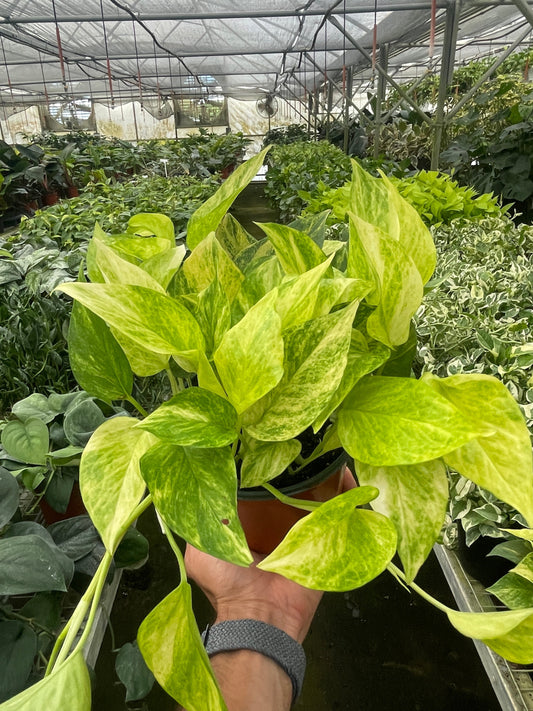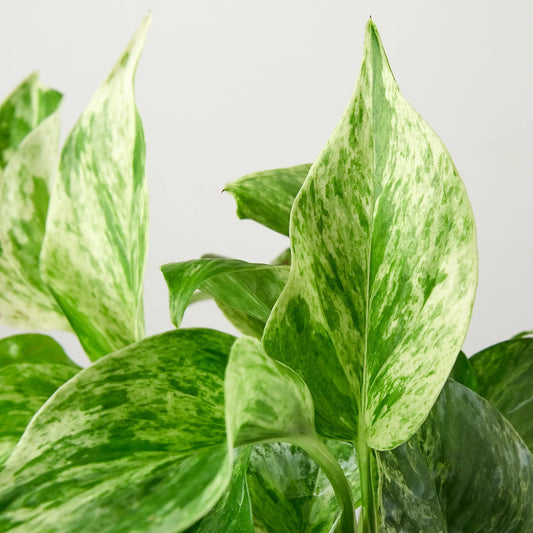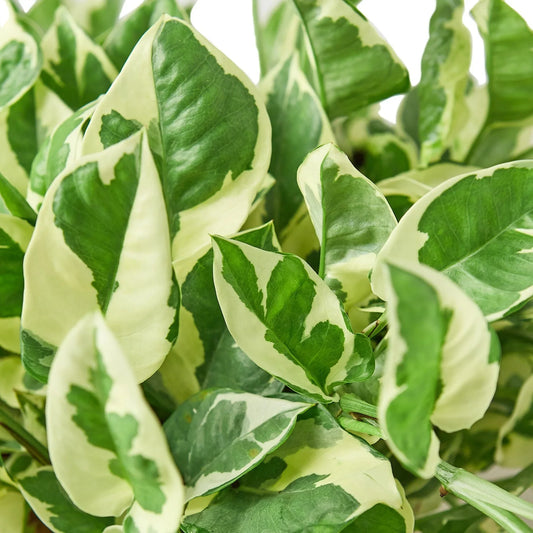Cebu Blue Pothos Fungal Infection (And How To Treat It)
Cafe Planta Team
If you're a proud plant parent of a Cebu Blue Pothos, you've likely admired its stunning, silvery-blue leaves that add a touch of elegance to any space. But what happens when those leaves start showing signs of distress? Fungal infections can be a real headache for plant lovers, leaving your once-vibrant plant looking a little sad.
This article will guide you through understanding, identifying, and treating fungal infections in your Cebu Blue Pothos. We'll cover what causes these infections, how to spot them early, and provide you with step-by-step solutions to nurse your plant back to health. Plus, we'll sprinkle in some tips on preventing future infections so you can keep your plant thriving.
What Causes Fungal Infections in Cebu Blue Pothos?
Before you can tackle a problem, it helps to know what you're up against. Fungal infections in Cebu Blue Pothos often arise due to environmental factors. Think of your plant's environment as its little universe. If the balance is off, it's like inviting unwanted guests—fungi, in this case.
Fungi love moisture. Overwatering is one of the biggest culprits when it comes to fungal infections. Cebu Blue Pothos prefers well-draining soil and a pot with drainage holes. Without these, excess water can lead to soggy roots and create a breeding ground for fungi.
Another factor is humidity. While these plants enjoy a humid environment, too much humidity combined with poor air circulation can encourage fungal growth. It's a delicate balance—like trying to keep a Goldilocks zone for your plant, not too dry and not too wet.
Lastly, sometimes it's just the luck of the draw. Spores can hitch a ride on new plants or even come in through open windows. This is why quarantine for new plants is a good practice, even if it sounds like a plant parent's paranoia.
Identifying Fungal Infections
Spotting a fungal infection early can save your Cebu Blue Pothos from serious damage. But how do you know it's a fungus and not just a case of the Mondays?
Common Symptoms
Here are some telltale signs:
- Leaf Spots: Look for brown or black spots on the leaves. These spots may have a yellow halo around them.
- Wilting Leaves: Fungal infections can cause leaves to wilt, even if you've been watering them correctly.
- Powdery Mildew: A white, powdery substance on the leaves is a clear sign of mildew.
- Root Rot: If you notice a foul smell or the roots are mushy when you unpot the plant, root rot is likely.
It can be tricky to distinguish between different plant issues, but a keen eye and a little detective work can go a long way. If you're unsure, you might want to consult a plant expert or reach out to your local plant community for advice.
Step-by-Step Treatment Plan
Once you've identified a fungal infection, the next step is action. Let's break it down into manageable steps, so you don't feel overwhelmed.
1. Isolate the Plant
The first thing you should do is move your plant away from others. Fungal infections can spread like gossip at a family reunion. Keeping it isolated helps protect your other plants.
2. Trim Affected Areas
Use sterilized scissors to cut away the infected leaves and stems. Be bold—it's better to prune more than leave infected parts that can spread the disease. Always sterilize your tools before and after to prevent contamination.
3. Adjust Watering Practices
Ensure you're not over-watering. Let the soil dry out a bit before the next watering session. Also, make sure the pot has adequate drainage to prevent waterlogging.
4. Improve Air Circulation
Place your plant in a spot with good air circulation. If needed, use a small fan to keep the air moving around your plant, which can help reduce humidity and prevent fungal growth.
5. Use a Fungicide
Consider using a fungicide to treat the infection. Organic options like neem oil can be effective. Follow the instructions on the product label, and apply it as directed.
6. Monitor and Repeat
Keep an eye on your plant and repeat treatment if necessary. Patience is key here—fungal infections don't disappear overnight, but with consistent care, you should see improvement.
Preventing Future Fungal Infections
Prevention is always better than cure, right? Here are some tips to keep your Cebu Blue Pothos fungus-free:
- Proper Watering: Stick to a watering schedule that allows the soil to dry out between waterings.
- Good Airflow: Ensure your plants aren't crammed together, which can lead to poor air circulation.
- Regular Inspection: Make a habit of checking your plants regularly for early signs of infection.
- Quarantine New Plants: Isolate new plants for a few weeks to prevent introducing new pests or diseases.
By being proactive, you can create an environment where your Cebu Blue Pothos (and other plants) can thrive without the threat of fungal infections hanging over them like a storm cloud.
Choosing the Right Soil and Pot
The soil and pot you choose can make a world of difference in preventing fungal infections. Cebu Blue Pothos prefers a well-draining potting mix. You can make your own by mixing equal parts of potting soil, perlite, and orchid bark. This mix provides excellent drainage, reducing the risk of overwatering.
When it comes to pots, always go for ones with drainage holes. It’s tempting to use that cute pot without holes, but trust me—your plant will thank you for keeping its roots dry. If you must use a decorative pot without drainage, consider placing your plant in a smaller plastic pot with holes, then placing it inside the decorative one. Just be cautious about excess water pooling at the bottom.
Understanding Humidity Levels
Cebu Blue Pothos loves humidity, but not too much of it. Finding the right balance can be tricky, especially if you live in a dry area. You might consider placing a small humidifier near your plant. Alternatively, grouping plants together can naturally increase humidity.
However, be cautious of overdoing it. Too much humidity can lead to fungal issues. A hygrometer can be a handy tool to monitor humidity levels around your plants, keeping them in the healthy range of 40-60%.
Healthy Fertilization Practices
Feeding your Cebu Blue Pothos the right way can boost its immune system, helping it fend off fungal infections. Use a balanced, water-soluble fertilizer every 4-6 weeks during the growing season. Avoid over-fertilizing, as this can stress the plant and make it more susceptible to disease.
Think of fertilizing like giving your plant a vitamin boost. Just as too many vitamins can be harmful to people, overdoing it with fertilizer can hurt your plant. Stick to the recommended dosage, and your plant will get the nutrients it needs without the risk of toxicity.
Community Support and Resources
Being part of a plant community can be invaluable. Whether it’s an online forum, social media group, or local plant club, these communities offer support, advice, and a sense of camaraderie. Sharing experiences with other plant people can provide new insights and solutions to common issues like fungal infections.
Don’t hesitate to reach out and ask questions. You might find that someone has dealt with the same issue and can offer a solution you hadn’t considered. Plus, who doesn’t love talking about plants with fellow enthusiasts?
When to Seek Professional Help
Sometimes, despite our best efforts, a fungal infection can be stubborn. If you've tried everything and your Cebu Blue Pothos still isn't getting better, it might be time to consult a professional.
Reach out to a local garden center or a professional plant care service. They can provide an expert diagnosis and treatment plan tailored to your specific situation. Remember, it’s okay to ask for help when things get out of hand.
Final Thoughts
Tackling a fungal infection in your Cebu Blue Pothos can seem daunting, but with a little patience and care, you can nurse your plant back to health. By understanding the causes, identifying symptoms early, and following a thorough treatment plan, you'll be well on your way to keeping your plant happy and healthy.
At Cafe Planta, we're passionate about helping plant lovers create thriving green spaces. Whether you're seeking new plant friends or need advice on plant care, we're here to support you. Feel free to email us or reach out through Instagram. Let's connect and grow our plant knowledge together!



















